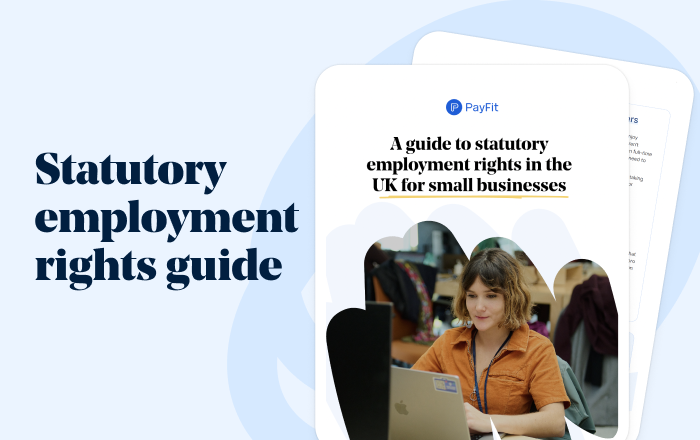✨ Health insurance, now in PayFit - learn more
💷 All the rates & thresholds you need to know for 25/26...right here
✨ The Payroll Journey: Start, Scale & Succeed Globally - learn more
✨ Health insurance, now in PayFit - learn more
💷 All the rates & thresholds you need to know for 25/26...right here
✨ The Payroll Journey: Start, Scale & Succeed Globally - learn more

Here is a brief summary of what employers need to know about redundancy consultation for one person:
There is no minimum statutory time period for an individual consultation (unlike the 30 or 45 days for collective redundancies).
Despite this, you must still carry out a meaningful consultation process in order to avoid an employment tribunal claim.
The business must have a genuine and demonstrable commercial reason for making the role redundant.
You must act fairly and reasonably at all times. This includes warning the employee, consulting with them, and exploring alternatives.
Failure in the process, not the redundancy itself, is often what leads to legal disputes. Providing a fair and accountable procedure is therefore essential.
Making redundancies is one of the hardest parts of scaling a business. For growing companies, this can often involve a single, difficult decision about one employee, rather than a large-scale exercise. Many employers mistakenly believe that if they are making only one person redundant, formal rules don’t apply. Unfortunately, it is not as simple as that, and there are significant legal and commercial considerations to take into account, and a specific redundancy consultation period.
UK employment law protects individual employees, as it does for groups, and every employer must follow due process. Even when dealing with a single employee, a structured process of consultation is essential, otherwise a costly employment tribunal claim may follow.
In this guide, we provide an overview of the redundancy consultation process for one person. We will cover the law, best practices, and the steps to take to ensure each dismissal is fair, lawful, and handled with compassion. This is vital for HR, finance and leadership teams, as well as corporate morale in general.

UK statutory employment rights guide
Before starting any process, you must be sure it is a genuine redundancy. A redundancy isn’t about performance, it is about a role no longer being needed.
Under UK employment law, a redundancy situation typically arises when:
The business is being wound down.
A specific workplace, such as a branch office or factory site, is being decommissioned.
The business’s demand for work of a particular kind has reduced or ended.
This third point is the most common in growing businesses. Your corporate and commercial needs are evolving. Perhaps a project in the construction or property sector has finished, technology makes the role obsolete, or a financial downturn requires cost-cutting measures. This business case is your foundation. Without it, the dismissal is not a redundancy.
Yes, collective consultation is different from individual consultation, in certain important aspects.
Collective consultation is triggered by law when an employer proposes to make 20 or more employees redundant at one establishment within 90 days. This process is highly regulated, with strict minimum time periods (30 or 45 days), and requires consultation with elected employee representatives, or, where there is a recognition agreement, a recognised trade union.
Individual consultation applies to everyone else (i.e. 1 to 19 redundancies). The same collective rules do not apply, but this does not mean there is no process. You still have a legal duty to consult adequately with each affected individual in order to ensure the dismissal is fair. The redundancy consultation process for one person refers to this individual approach.
Proper planning is everything. Rushing this stage is where employers typically make mistakes.
First, your leadership and finance teams must establish and document the business case. Why is this role at risk? Be specific. “Saving money” is a motive, not a business case. "We are outsourcing our customer support function... which means the in-house support agent role is no longer required” is a business case. This planning will help you, in turn, to define the ‘selection pool’.
The selection pool is the grouping of employees from which you select for redundancy. If you have three people doing the same job and only need two, your pool is three.
Often, you may have a ‘pool of one’. This happens when an employee has a unique role. It may seem obvious that this individual is automatically selected, but you must justify and document exactly how the decision has been reached.
An employee could easily argue that the selection should have been wider (e.g. in case their work overlaps with an ‘Operations Assistant’). So, you must have a solid, commercial rationale for the size of the grouping you define.
If your selection pool contains more than one person, you must use a fair and objective selection matrix. Criteria should be non-discriminatory, using objective metrics such as:
Skills, qualifications and experience relevant or not to remaining roles.
Standards of work and performance, based on objective records, such as appraisals, duly recorded in a structured and accountable performance management system.
Attendances and disciplinary records that are fact-based and well-documented in an effective HR management system.
You must avoid criteria that are subjective or discriminatory. For example, selection based on age, part-time status or nationality (or related matters, such as immigration status) would be automatically discriminatory and illegal.
It is important that the process is not a single event, but rather a series of good-faith conversations. Its purpose is to discuss the situation with the affected employee, and to jointly explore any possibility to avoid their redundancy.
Your first meeting is not to make the employee redundant. It is to warn them that their role is at risk of redundancy.
In this meeting, you should:
Explain the business reason and exactly why their role is at risk.
Explain the pool selection criteria used.
Outline the consultation process and likely time scales.
Give the employee time to absorb the information and ask initial questions.
Remind them of their right to be accompanied to future meetings by a work colleague or a trade union representative.
This initial meeting must then be followed-up in writing, to document all of this information.
After the initial warning, you must hold at least one further consultation meeting, and preferably two or more. The consultation must be considered a two-way street. So you should enter the room with an open mind, listen, and genuinely consider the employee’s suggestions.
You should discuss:
The business reasons, and any counter-proposals the employee has.
The selection criteria used and their justification.
Most importantly, any possible alternatives to redundancy.
A consultation can only be considered meaningful if you actively try to identify ways to avoid the dismissal. You must, for example, search for and discuss suitable alternative employment within your business. Remember that this is not a favour to your employee, it is an actual legal requirement.
So, look for other available roles. An alternative role may be at a different pay grade, or on different terms. Suitable roles must be genuinely offered. If the employee unreasonably refuses an identified suitable alternative, they may then lose their right to statutory redundancy pay.
Other alternatives to discuss include reducing hours, cutting costs elsewhere, or stopping the use of contractors or outsourcing. Providing documented evidence that you have adequately considered these options is essential in order to prevent disputes further on.
This is a common question. For an individual, there is no statutory minimum period.
Guidance from ACAS, the Advisory, Conciliation and Arbitration Service, clarifies that there is ‘no set time’ but that consultation must be ‘meaningful’. Rushing things implies that you have already decided a priori.
As best practice, a reasonable duration is typically two to three weeks. This allows time for the ‘at risk’ meeting, a few days for reflection, a second consultation, and then a final decision. You must give the employee adequate time to respond.
After you have fully consulted, and have found no alternatives, you can move on to the final stages.
If you decide to proceed with the redundancy, you must hold a final meeting. In this meeting, you will confirm the decision to terminate the employment by reason of redundancy.
This must be followed up by a written dismissal letter. This should confirm:
The reason for the redundancy.
The final date of employment.
Details of the notice period given.
The employee’s right of appeal.
A calculation of their final pay.
The HR and finance departments’ roles are crucial here. The final pay must be accurate and include:
Notice period pay (either worked or as Payment In Lieu of Notice, depending on the employment contract, corporate policies, and/or employee handbook).
Any accrued but untaken holiday pay.
Statutory Redundancy Pay (SRP), if the employee has two or more years of service behind them. You can use the UK government’s tool to calculate this, or your payroll system should provide it.
Some employers offer enhanced redundancy pay. These payments are sometimes part of a Settlement Agreement, that is, a separate legal agreement where an employee waives their right to bring claims in return for an agreed payment. This provides the business with legal certainty going forward.
The main danger is a claim for unfair dismissal at an employment tribunal.
A tribunal will not question your commercial decision to make a redundancy. It won’t second-guess whether your business in the property or construction sector needed to downsize.
However, a tribunal will scrutinise your process. If you failed to consult, used unfair selection criteria, or didn’t explore alternatives, they will likely find the dismissal procedurally unfair. This can lead to compensation, legal fees, and brand damage. Following the procedural advice and best practices is not just good HR, it can be an essential part of risk management too.

The redundancy process is a specific, no-fault type of dismissal based on the business’s corporate needs, where the role, not the person, is the reason. Other dismissals are typically related to an individual’s conduct/misconduct, or capability/performance.
The Statutory Redundancy Pay calculation is based on an employee’s age, length of service (over two years), and weekly pay (up to a statutory cap), and using adequate HR and payroll management software, such as PayFit’s, can help you work it out in a jiffy.
If you offer an employee suitable alternative employment, they have a statutory 4-week trial period in that new role. This allows both you and the employee to ensure the role is a good fit. If it isn't (for a good reason), they can still receive their original redundancy pay.
If you make a mistake in the process, it’s best to get legal advice immediately. Sometimes, mistakes can be corrected just in time. However, a significant procedural error often makes a dismissal procedurally flawed. Staying compliant with UK employment law from the start is the best strategy.
Absolutely. Managing the final payment, including notice, holidays and redundancy pay is complex. Using a powerful payroll solution automates these calculations, ensures tax and NI are handled correctly, and provides a clear, compliant payslip for the departing employee, reducing errors and disputes.

Learn what constructive dismissal compensation is, how it’s calculated, and the best practices UK employers should follow to avoid costly tribunal claims.

Understand voluntary redundancy, its legal requirements, best practices, impacts for UK businesses, & considerations for HR, finance & business leaders.

Our guide helps managers understand UK redundancy rights & efficiently handle redundancy, calculate pay, ensure compliance & avoid costly tribunal claims.

This article provides guidance on the redundancy process, to help UK employers understand their obligations and the rights of their employees.

Contract terminations aren’t easy. This guide covers what to do as an employer when you have a redundancy, settlement agreement, death or non-starter.